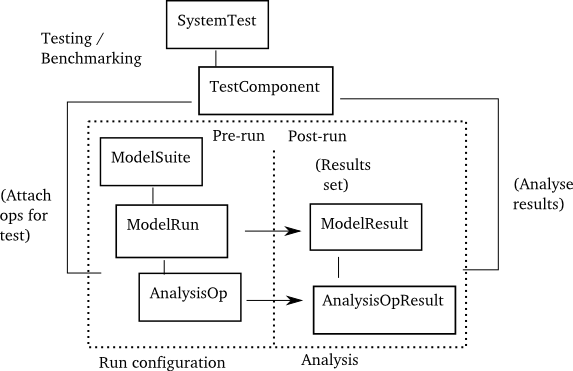Core CREDO Architecture¶
This section is aimed to give you a quick overview of the architecture of the CREDO toolkit. It’s strongly suggested you read at least the How CREDO fits into the workflow of using the Underworld modelling code section from the introductory section first, to put this in perspective. This architecture description may help illustrate the Examples of how to use CREDO, and help explain the details in the CREDO Python Source API Documentation.
This diagram gives an idea of the essential architecture of the CREDO toolkit’s classes:

The diagram shows that the CREDO framework works at two main levels:
- Running and analysis of models (inside the dotted box): ability to construct a Model Run, run it, and analyse the results.
- Testing and benchmarking: run and analyse models in defined ways, to allow system testing. Thus, if CREDO is being used purely for testing, it can operate at a high-level of abstraction and manage the details of constructing and analysing models [1].
Inside the dotted lines are shown the core Analysis functionality and classes. They implement the concept discussed in the How CREDO fits into the workflow of using the Underworld modelling code, of the ability to abstract and manage a StGermain-based code simulation through the concepts of a Model Run and Model Result. For each ModelRun, one or more analysis operations (AnalysisOps) can be applied to it, which will also produce data that can be referenced through an AnalysisResult.
Thus what essentially happens for an analysis or testing run is generally:
- A script constructs a ModelRun (or suite of runs as a ModelSuite), and customises it, possibly including specifying AnalysisOps.
- The model is ran, producing a ModelResult class.
- This class can then be used as a basis for post-processing, with a defined set of capabilities that allow the user to explore the results of the model, and perform analysis on those results.
Note
In future, we may allow the ability of running a set of AnalysisOps as a post-processing operation on the results of a ModelRun, based on checkpointed data. However, this feature is not currently implemented.
The examples in the Examples of how to use CREDO section help illustrate how these capabilities work in practice.
Organisation of Python Code and class hierarchy¶
As usual for Python projects, the code is separated into a set of directories of related functionality called packages, which are then further divided into individual modules.
Note
CREDO uses Python’s object-oriented capabilities to manage a set of Classes to implement this architecture. Python is designed to be easy to pick up, and from a user’s perspective the object-oriented features shouldn’t make scripting difficult. Thus if you only intend to write CREDO scripts to perform analysis, you should be able to move straight to the Examples of how to use CREDO without worrying about how Python classes work in detail. However if you intend to add and develop new Analysis capabilities, you may wish to run through the Python tutorial’s section on Classes as a primer to get you started.
These key models and packages are described and documented in the CREDO Python Source API Documentation section. The linked diagrams below show several of the key classes that implement the architecture discussed above:
The core ModelRun, ModelResult and Analysis hierarchy:
And several key System testing classes:
Footnotes
| [1] | Although for complex benchmarks, the user will likely need to work with and customise the models at a more detailed level, which is supported. |